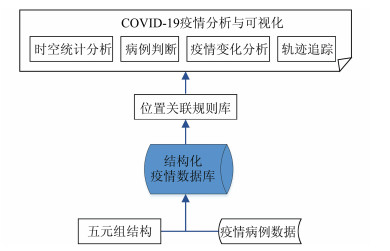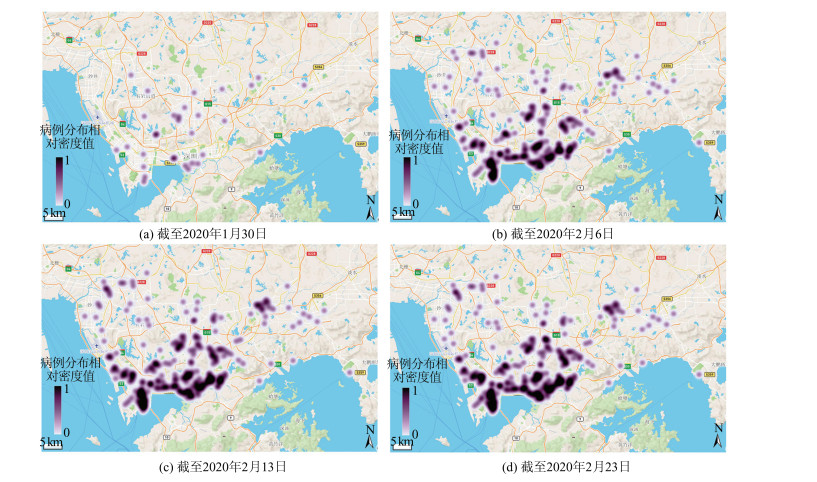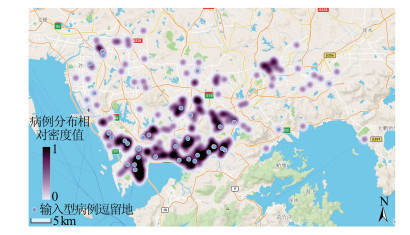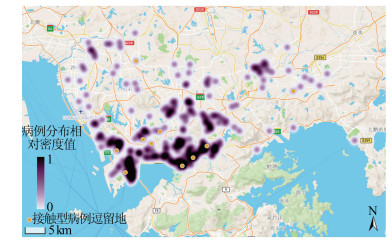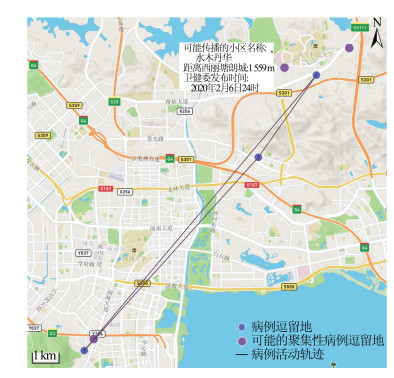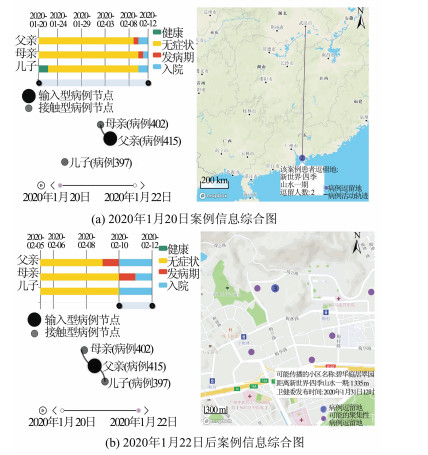Spatial-Temporal Analysis of COVID-19 Transmission Based on Geo-Location Linked Data
-
摘要: 新型冠状病毒肺炎(coronavirus disease 2019,COVID-19)暴发以来,许多研究对COVID-19的发生和发展进行了分析和预测,但鲜见采用GIS空间分析技术进行COVID-19流行病学调查的研究。不同于医学的病毒原理和大数据分析方法,将流行病学调查知识与位置关联分析相结合,利用五元组模型结构化每个病例数据,采用GIS时空交叠原理处理病例数据,定义统计分类和传播分析的五元组操作规则,实现了确诊病例的分时、分区统计以及输入型、接触型和聚集性病例的判断、挖掘和疾病传播过程的分析。结果显示,五元组结构及其操作规则可实现病例数据的计算机自动化处理,能够快速获取疫情发展状况,推演疫情传播过程。五元组模型结合时序图、关系图等可视化技术能够有效地分析和展示疾病、健康或卫生事件的分布和传播情况,为疾控机构快速掌握疫情传播状况提供支持。Abstract: Spatial-temporal analysis method provides technical support for epidemiological investigation. To analyse and demonstrate the transmission of coronavirus disease 2019(COVID-19), this paper takes the data of COVID-19 cases in Shenzhen as an example, combines epidemiological investigation knowledge with geo-location linked association analysis, and uses the spatial-temporal five-tuple model to structure and analyze the case data. Rules based on spatial-temporal five-tuple model for case type judgment and statistical analysis are defined, which can use spatial-temporal overlap principles to judge two types of cases, input cases and contact cases, and to make temporal statistics and zoning statistics about the confirmed cases. This paper defines the five-tuple model and its operation rules for judging and analyzing the epidemic gathering situation, which can use the principle of spatial-temporal overlap to judge and mine the epidemic gathering situation and to analyze its propagation process. Combined with GIS spatial-temporal visualization, the entire process of epidemic developments and transmission are displayed in the maps with interactive interface along with temporal series diagrams and social relationship diagrams. During the spreading stage of the epidemic situation, by updating the case data and implementing the analysis, the spatial-temporal five-tuple structure and its operating rules could be feasible to judge, deduce quickly and show the changing status of the epidemic simultaneously with their visualization. The spatial-temporal five-tuple model combined with visualization technology can effectively display the distribution and transmission of the diseases, health or hygiene events, and provide support for disease control agencies to understand and control the spread of epidemic conditions.
-
-
表 1 时空五元组模型元素及示例
Table 1 Elements and Examples of Spatial-Temporal Five-Tuple Model
五元组 病例信息属性 示例 主体 病例号 病例231 活动 患者的行为或状态 探亲、逗留(仅限于位置在深圳的情况)、来深圳、发病、入院、接触 对象 与患者接触的对象 病例1(病例231父亲) 时间 患者进行活动的时间点或时间段 2020-01-23 位置 患者所在位置名称,经度,纬度 幸福小区,116.21, 28.33 -
[1] Brody H, Rip M R, Vinten-Johansen P, et al. Map-Making and Myth-Making in Broad Street: The London Cholera Epidemic, 1854[J]. The Lancet, 2000, 356(9 223):64-68
[2] Musa G J, Chiang P H, Sylk T, et al. Use of GIS Mapping as a Public Health Tool—From Cholera to Cancer[J]. Health Services Insights, 2013, 6 :111-116
[3] Koch T. Knowing Its Place: Mapping as Medical Investigation[J]. The Lancet, 2012, 379(9 819):887-888
[4] Cliff A D, Smallman-Raynor M R, Stevens P M. Controlling the Geographical Spread of Infectious Disease: Plague in Italy, 1347—1851[J]. Acta Medico—Historica Adriatica: AMHA, 2009, 7(2):197-236
[5] 张孟林.基于GIS技术分析枣庄市农村地区2014—2016年感染性腹泻流行病学特征[D].青岛: 青岛大学, 2019 Zhang Menglin. Analysis of Epidemiologic Characteristics About Infectious Diarrheal Diseases in the Rural Areas of Zaozhuang City, 2014—2016 Based on GIS[D]. Qingdao: Qingdao University, 2019
[6] 韩鹏宇, 毕秀欣, 陈津津.GIS技术在国境口岸卫生检疫工作中的应用前景探索[J].口岸卫生控制, 2019, 24(1):3-5 http://d.old.wanfangdata.com.cn/Periodical/kawskz201901003 Han Pengyu, Bi Xiuxin, Chen Jinjin. Prospect of the Application of GIS in Border Health Quarantine[J]. Port Health Control, 2019, 24(1):3-5 http://d.old.wanfangdata.com.cn/Periodical/kawskz201901003
[7] 卢易, 王烁, 易敬涵, 等.基于GIS的中国非洲猪瘟疫情风险分析[J].中国兽医学报, 2019, 39(1):8-13 http://d.old.wanfangdata.com.cn/Periodical/zgsyxb201901002 Lu Yi, Wang Shuo, Yi Jinghan, et al. Risk Analysis of African Swine Fever in China Based on GIS[J]. Chinese Journal of Veterinary Science, 2019, 39(1):8-13 http://d.old.wanfangdata.com.cn/Periodical/zgsyxb201901002
[8] 马佳, 张知新, 裴韬, 等.地理信息系统在疾病防控与医疗资源配置中的研究进展[J].川北医学院学报, 2018, 33(6):957-961 http://d.old.wanfangdata.com.cn/Periodical/cbyxyxb201806042 Ma Jia, Zhang Zhixin, Pei Tao, et al. The Latest Researches About Application of GIS in Disease Prevention and Allocation of Medical Resources[J]. Journal of North Sichuan Medical College, 2018, 33(6):957-961 http://d.old.wanfangdata.com.cn/Periodical/cbyxyxb201806042
[9] 张蓉, 李艳红.空间流行病学在传染性疾病预防与控制中的应用[J].疾病监测与控制, 2018, 12(2):134-138 http://d.old.wanfangdata.com.cn/Periodical/jbjcykz201802016 Zhang Rong, Li Yanhong. Application of Spatial Epidemiology in Infectious Disease Prevention and Control[J]. Journal of Diseases Monitor and Control, 2018, 12(2):134-138 http://d.old.wanfangdata.com.cn/Periodical/jbjcykz201802016
[10] 郑嘉丽.传染病的多尺度时空特征分析及其风险因子探究[D].杭州: 浙江大学, 2018 http://cdmd.cnki.com.cn/Article/CDMD-10335-1018016053.htm Zheng Jiali. Analysis of Multi-scale Spatial-Temporal Characteristics and Risk Factors of Infectious Diseases[D]. Hangzhou: Zhejiang University, 2018 http://cdmd.cnki.com.cn/Article/CDMD-10335-1018016053.htm
[11] 赵帅然, 周达岸.地理信息系统在医学研究中的应用[J].锦州医科大学学报, 2018, 39(5):100-102 http://d.old.wanfangdata.com.cn/Periodical/wsyj200402043 Zhao Shuairan, Zhou Daan. The Application of Geographic Information System in Medical Research[J]. Journal of Jinzhou Medical University, 2018, 39(5):100-102 http://d.old.wanfangdata.com.cn/Periodical/wsyj200402043
[12] 中华预防医学会新型冠状病毒肺炎防控专家组.新型冠状病毒肺炎流行病学特征的最新认识[J].中华流行病学杂志, 2020, 41(2):139-144 http://d.old.wanfangdata.com.cn/Periodical/zhlxbx202002002 Special Expert Group for Control of the Epidemic of Novel Coronavirus Pneumonia Preventive of the Chinese Medicine Association. An Update on the Epidemiological Characteristics of Novel Coronavirus Pneumonia (COVID-19)[J]. Chinese Journal of Epidemiology, 2020, 41(2):139-144 http://d.old.wanfangdata.com.cn/Periodical/zhlxbx202002002
[13] Gao Y, Yan L, Huang Y, et al. Structure of the RNA-Dependent RNA Polymerase from COVID-19 Virus[J]. Science, 2020, 368(6 492):779-782
[14] Guan W, Ni Z, Hu Y, et al. Clinical Characteristics of 2019 Novel Coronavirus Infection in China[EB/OL]. http://dx.doi.org/10.1101/2020.02.06.20020974,2020
[15] Forster P, Forster L, Renfrew C, et al. Phylogenetic Network Analysis of SARS-CoV-2 Genomes[J]. Proceedings of the National Academy of Sciences, 2020, 117(17):9 241-9 243
[16] 刘张, 千家乐, 杜云艳, 等.基于多源时空大数据的区际迁徙人群多层次空间分布估算模型——以COVID-19疫情期间自武汉迁出人群为例[J].地球信息科学学报, 2020, 22(2):147-160 Liu Zhang, Qian Jiale, Du Yunyan, et al. Multi-level Spatial Distribution Estimation Model of the Inter-regional Migrant Population Using Multi-source Spatio-Temporal Big Data: A Case Study of Migrants from Wuhan During the Spread of COVID-19[J]. Journal of Geo-information Science, 2020, 22(2):147-160
[17] 王旭艳, 喻勇, 胡樱, 等.基于指数平滑模型的湖北省新冠肺炎疫情预测分析[J].公共卫生与预防医学, 2020, 31(1):1-4 http://d.old.wanfangdata.com.cn/Periodical/ggwsyyfyx202001001 Wang Xuyan, Yu Yong, Hu Ying, et al. COVID-19 Analysis and Forecast Based on Exponential Smoothing Model in Hubei Province[J]. Journal of Public Health and Preventive Medicine, 2020, 31(1):1-4 http://d.old.wanfangdata.com.cn/Periodical/ggwsyyfyx202001001
[18] 傅家旗, 刘敏, 邓春燕, 等.复杂人流网络下的COVID-19传播模型[J].电子科技大学学报, 2020, 49(3):383-391 http://d.old.wanfangdata.com.cn/Periodical/dzkjdxxb202003011 Fu Jiaqi, Liu Min, Deng Chunyan, et al. Spreading Model of the COVID-19 Based on the Complex Human Mobility[J]. Journal of University of Electronic Science and Technology of China, 2020, 49(3):383-391 http://d.old.wanfangdata.com.cn/Periodical/dzkjdxxb202003011
[19] 陈田木, 赵泽宇, 芮佳, 等.厦门市新冠肺炎传播能力计算与防控措施效果的模拟评估[J/OL].厦门大学学报(自然科学版), 2020, http://kns.cnki.net/kcms/detail/35.1070.n.20200402.1051.002.html Chen Tianmu, Zhao Zeyu, Rui Jia, et al. Estimating the Transmissibility of COVID-19 and Assessing the Effectiveness of the Countermeasures to Control the Disease in Xiamen City[J/OL]. Journal of Xiamen University(Natural Science), 2020, http://kns.cnki.net/kcms/detail/35.1070.n.20200402.1051.002.html
[20] Zhou C, Su F, Pei T, et al. COVID-19: Challenges to GIS with Big Data[J/OL]. Geography and Sustainability, 2020, https://dx.doi.org/10.1016/j.geosus.2020.03.005
[21] 殷钊.基于地理位置的社会信息的信息关联和可视化研究[D].北京: 北京大学, 2014 http://d.wanfangdata.com.cn/Thesis/Y2666811 Yin Zhao. Research on Information Association and Visualization of Social Information Based on Geographical Location[D]. Beijing: Beijing University, 2014 http://d.wanfangdata.com.cn/Thesis/Y2666811
[22] 蒋小荣, 汪胜兰, 杨永春.中国城市人口流动网络研究——基于百度LBS大数据分析[J].人口与发展, 2017, 23(1):13-23 http://www.wanfangdata.com.cn/details/detail.do?_type=perio&id=671500539 Jiang Xiaorong, Wang Shenglan, Yang Yongchun. Research on China's Urban Population Mobility Network Based on Baidu LBS Big Data[J]. Population and Development, 2017, 23(1):13-23 http://www.wanfangdata.com.cn/details/detail.do?_type=perio&id=671500539
[23] 李德仁, 邵振峰, 于文博, 等.基于时空位置大数据的公共疫情防控服务让城市更智慧[J].武汉大学学报·信息科学版, 2020, 45(4):475-487, 556 doi: 10.13203/j.whugis20200145 Li Deren, Shao Zhenfeng, Yu Wenbo, et al. Public Epidemic Prevention and Control Services Based on Big Data of Spatiotemporal Location Make Cities more Smart[J]. Geomatics and Information Science of Wuhan University, 2020, 45(4):475-487, 556 doi: 10.13203/j.whugis20200145
[24] 中国疾病预防控制中心.新型冠状病毒肺炎流行病学调查指南[EB/OL]. http://www.chinacdc.cn/jkzt/crb/zl/szkb_11803/jszl_11815/202003/W020200309540843000869.pdf, 2020 Chinese Center for Disease Control and Prevention. Guidelines for the Epidemiological Investigation of Novel Coronavirus Pneumonia[EB/OL]. http://www.chinacdc.cn/jkzt/crb/zl/szkb_11803/jszl_11815/202003/W020200309540843000869.pdf, 2020
[25] 许小可, 文成, 张光耀, 等.新冠肺炎暴发前期武汉外流人口的地理去向分布及影响[J/OL].电子科技大学学报, 2020, http://kns.cnki.net/kcms/detail/51.1207.T.20200213.2002.002.html Xu Xiaoke, Wen Cheng, Zhang Guangyao, et al. The Geographical Destination Distribution and Effect of Outflow Population of Wuhan When the Outbreak of the 2019-nCoV Pneumonia[J/OL]. Journal of University of Electronic Science and Technology of China, 2020, http://kns.cnki.net/kcms/detail/51.1207.T.20200213.2002.002.html
[26] 詹思延.流行病学[M]. 8版.北京:人民卫生出版社, 2017 Zhan Siyan. Epidemiology[M]. 8th ed. Beijing: People's Medical Publishing House, 2017
[27] 陈坤平.移动互联环境下的位置数据关联研究[D].武汉: 武汉大学, 2018 Chen Kunping. Geo-Linked Data Model and Analysis in Mobile Internet Environment[D]. Wuhan: Wuhan University, 2018
[28] 中国疾病预防控制中心.新型冠状病毒肺炎聚集性疫情流行病学调查指南[EB/OL]. http://www.chinacdc.cn/jkzt/crb/zl/szkb_11803/jszl_11815/202002/W020200220475075382229.pdf, 2020 Chinese Center for Disease Control and Prevention. A Guide to the Epidemiological Investigation of Novel Coronavirus Pneumonia Clustered Epidemic Situation[EB/OL]. http://www.chinacdc.cn/jkzt/crb/zl/szkb_11803/jszl_11815/202002/W020200220475075382229.pdf, 2020
[29] Tian H Y, Liu Y H, Li Y D, et al. The Impact of Transmission Control Measures During the First 50 Days of the COVID-19 Epidemic in China[EB/OL]. https://doi.org/10.1101/2020.01.30.20019844, 2020
-
期刊类型引用(46)
1. 刘春雷,张媛静,陆晨明,李亚松,李剑锋. 基于时序InSAR的九龙江河口地区地面沉降时空演变规律及成因分析. 应用海洋学学报. 2024(01): 116-125 .  百度学术
百度学术
2. 陈瑞瑞,孙颢月,朱紫若,蒋雪中,陈沈良,陈静. 黄河三角洲地面沉降研究进展与未来展望. 海岸工程. 2024(01): 1-23 .  百度学术
百度学术
3. 赵凤阳,周吕,魏玉业. 融合改进鲸鱼算法解缠的梧州市地面沉降InSAR监测. 遥感信息. 2024(01): 52-58 .  百度学术
百度学术
4. 侯永浩,张兴,李晓民,李宗仁. SBAS-InSAR技术在地质灾害调查中的应用. 北京测绘. 2024(10): 1477-1481 .  百度学术
百度学术
5. 柳新强,姜刚,刘军峰,贺国伟. PS-InSAR和SBAS-InSAR的地表沉降监测对比研究——以雄安新区为例. 工程勘察. 2023(01): 62-67 .  百度学术
百度学术
6. 曾敏,皮鹏程,赵信文,陈松,彭红霞,侯清芹,孙慧敏,薛紫萱. 基于PS-InSAR的珠江口典型填海造地区地面沉降时空特征研究. 华南地质. 2023(01): 116-126 .  百度学术
百度学术
7. 李文慧,王志伟,赵月,王翔. 基于SNAP-StaMPS方法的高速公路沿线地面沉降监测. 测绘工程. 2023(03): 36-43 .  百度学术
百度学术
8. 周定义,左小清,赵志芳,喜文飞,葛楚. 基于SBAS-InSAR和改进BP神经网络的城市地面沉降预测. 地质通报. 2023(10): 1774-1783 .  百度学术
百度学术
9. 刘泽洲,卢才武,章赛,李萌,和郑翔. 基于多阈值目标提取的时序InSAR矿区地表沉降监测研究. 中国矿业. 2022(08): 79-85 .  百度学术
百度学术
10. 王新田,刘增珉,陈建忠,梁菲,孟萌,李天鹤. 山东省地表形变InSAR监测与分析. 测绘通报. 2022(S2): 130-134 .  百度学术
百度学术
11. 邓晓景,曲国庆,张建霞,席换,王晖. 融合升降轨PS-InSAR东营市地面沉降监测. 山东理工大学学报(自然科学版). 2021(01): 10-16 .  百度学术
百度学术
12. 杨利,薛东剑,王海方,付林,张婷. 五龙沟矿区时序InSAR地表形变监测. 中国矿业. 2021(03): 107-112 .  百度学术
百度学术
13. 程琳琳,杨玉曼,李月颖,孙梦尧,王振威,焦路尧. 矿业型村镇转型期发展问题分析与策略研究:以北京市门头沟区为例. 中国矿业. 2021(03): 101-106 .  百度学术
百度学术
14. 王辉,曾琪明,焦健,陈继伟. 结合序贯平差方法监测地表形变的InSAR时序分析技术. 北京大学学报(自然科学版). 2021(02): 241-249 .  百度学术
百度学术
15. 付云霞,管勇,王晓丹,王建收,尹政,周晓雪,王青,徐美君. 大型河口三角洲地面沉降机制研究——以黄河三角洲为例. 海岸工程. 2021(02): 83-95 .  百度学术
百度学术
16. 关金环,高明亮,宫辉力. 首都国际机场区域差异性沉降原因探讨. 测绘科学. 2021(09): 67-75 .  百度学术
百度学术
17. 柴华彬,胡吉彪,耿思佳. 融合实测数据的地表沉降SBAS-InSAR监测方法. 煤炭学报. 2021(S1): 17-24 .  百度学术
百度学术
18. 程霞,张永红,邓敏,吴宏安,康永辉. Sentinel-1A卫星的黄河三角洲近期地表形变分析. 测绘科学. 2020(02): 43-51 .  百度学术
百度学术
19. 卢旺达,韩春明,岳昔娟,赵迎辉,周格仪. 基于Sentinel-1A数据的天津地区PS-InSAR地面沉降监测与分析. 遥感技术与应用. 2020(02): 416-423 .  百度学术
百度学术
20. 向淇文,潘建平,张广泽,徐正宣,张定凯,涂文丽. 基于SBAS技术的川藏铁路折多山地区地表形变监测与分析. 测绘工程. 2020(04): 48-54+59 .  百度学术
百度学术
21. 张金盈,崔靓,刘增珉,王新田,林琳,徐凤玲. 利用Sentinel-1 SAR数据及SBAS技术的大区域地表形变监测. 测绘通报. 2020(07): 125-129 .  百度学术
百度学术
22. 狄桂栓. 基于InSAR技术的黄河三角洲区域地表形变浅析. 地理空间信息. 2020(09): 106-109+8 .  百度学术
百度学术
23. 高辉,罗孝文,吴自银,阳凡林. 基于时序InSAR的珠江口大面积地面沉降监测. 海洋学研究. 2020(02): 81-87 .  百度学术
百度学术
24. 韩红花. 黄河三角洲区域地表形变监测研究. 山东国土资源. 2020(11): 69-72 .  百度学术
百度学术
25. 夏元平,陈志轩,张毅. 南昌市地面沉降InSAR监测及影响因子分析. 测绘科学. 2020(11): 115-122+129 .  百度学术
百度学术
26. 贺跃光,肖亮. 某水溶开采矿区短基线集InSAR高相干点探测. 中国锰业. 2019(01): 89-93 .  百度学术
百度学术
27. 张静,丁黄平,刘纯,谢文然,时雨. 基于InSAR技术的盘锦地区地面沉降研究. 世界地质. 2019(02): 574-580 .  百度学术
百度学术
28. 韩红超,符华年,张文峰,温浩. InSAR、水准多维沉降监测体系建设及应用研究. 测绘通报. 2019(S1): 236-241 .  百度学术
百度学术
29. 师芸,李伟轩,唐亚明,席磊,孟欣. 时序InSAR技术在地球环境监测及其资源管理中的应用:以交城-清徐地区为例. 武汉大学学报(信息科学版). 2019(11): 1613-1621 .  百度学术
百度学术
30. 杨帆,王道顺,张磊,张子文. 基于时序InSAR的隧道工程形变监测与分析. 测绘与空间地理信息. 2019(10): 1-4 .  百度学术
百度学术
31. 黄洁慧,谢谟文,王立伟. 基于SBAS-InSAR技术的白格滑坡形变监测研究. 人民长江. 2019(12): 101-105 .  百度学术
百度学术
32. 黄洁慧,谢谟文,王立伟. 基于差分干涉合成孔径雷达技术的米林滑坡形变监测. 科学技术与工程. 2019(25): 7-12 .  百度学术
百度学术
33. 李锁乐,吴宏安,张永红,康永辉,左振华. 包头市地面沉降高分辨率时序InSAR监测. 测绘科学. 2018(09): 76-80 .  百度学术
百度学术
34. 杨帆,张磊,张子文,赵增鹏. 利用短基线集InSAR技术监测抚顺市地面沉降. 测绘通报. 2018(03): 84-88 .  百度学术
百度学术
35. 张静,冯东向,綦巍,周雪,赵玉星. 基于SBAS-InSAR技术的盘锦地区地面沉降监测. 工程地质学报. 2018(04): 999-1007 .  百度学术
百度学术
36. 贺晓阳,赵盟,程存付. 小基线集技术在矿区地表形变监测中的应用. 河南科技. 2018(13): 97-98 .  百度学术
百度学术
37. LIU Xiao,LIU Jie,FENG Xiuli. Inversion and Prediction of Consolidation Settlement Characteristics of the Fluvial Sediments Based on Void Ratio Variation in the Northern Modern Yellow River Subaqueous Delta, China. Journal of Ocean University of China. 2018(03): 545-554 .  必应学术
必应学术
38. 李达,邓喀中,高晓雄,牛海鹏. 基于SBAS-InSAR的矿区地表沉降监测与分析. 武汉大学学报(信息科学版). 2018(10): 1531-1537 .  百度学术
百度学术
39. 张炜,张伟胜,张东升,胡文敏,孙毓言,唐佳佳. 采动覆岩活动规律的“空-地”监测技术. 中国矿业大学学报. 2018(06): 1212-1223 .  百度学术
百度学术
40. 王小侣. 水电站大坝400V备自投改造研究. 河南科技. 2018(19): 90-91 .  百度学术
百度学术
41. 张磊,杨帆,李超飞,赵增鹏,张子文. 宁波地面沉降的短基线集监测与分析. 测绘科学. 2017(12): 77-82 .  百度学术
百度学术
42. 陈继伟,曾琪明,焦健,赵斌臣. Sentinel-1A卫星TOPS模式数据的SBAS时序分析方法——以黄河三角洲地区为例. 国土资源遥感. 2017(04): 82-87 .  百度学术
百度学术
43. 王萍. 沉降观测技术在高层建筑施工中的应用. 建材与装饰. 2017(35): 19-20 .  百度学术
百度学术
44. 史秀保,徐宁,温浩,李春进. 一种小基线地表形变监测精度评价方法. 测绘通报. 2016(08): 70-73+91 .  百度学术
百度学术
45. 于丹,杨子玉,庄岩,于均园. 时序分析法在沈阳地铁二号线变形预测的应用. 沈阳建筑大学学报(自然科学版). 2016(03): 453-458 .  百度学术
百度学术
46. 王霖郁,李辉. 一种枝切法和质量图相结合的InSAR相位解缠算法. 应用科技. 2016(05): 49-53 .  百度学术
百度学术
其他类型引用(25)






 下载:
下载:
